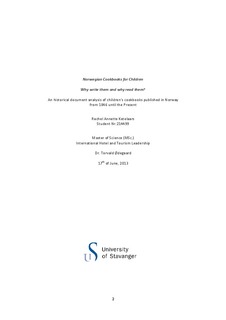| dc.contributor.author | Ketelaars, Rachel Annette | |
| dc.date.accessioned | 2013-11-01T12:02:59Z | |
| dc.date.available | 2013-11-01T12:02:59Z | |
| dc.date.issued | 2013-06-17 | |
| dc.identifier.uri | http://hdl.handle.net/11250/185189 | |
| dc.description | Master's thesis in International hotel and tourism management | no_NO |
| dc.description.abstract | Cookbooks for children are not only instructional manuals for the culinary arts and repositories for traditional dishes; they also reflect food habits of a population and their values on children. Evidence of this was gathered from Norwegian cookbooks, published between 1833 and 2013, found from secondary sources and in the libraries in the Stavanger region. Textual analysis of these cookbooks for children included an examination of their authors, audience, and contents. The results validated the claim that a cookbook can be regarded as a socio-historic and cultural document that is worthy of additional academic attention than presently exists. | no_NO |
| dc.description.sponsorship | Norwegian Cookbook Museum | no_NO |
| dc.language.iso | eng | no_NO |
| dc.publisher | University of Stavanger, Norway | no_NO |
| dc.relation.ispartofseries | Masteroppgave/UIS-SV-NHS/2013; | |
| dc.relation.ispartofseries | ISSN; | |
| dc.subject | hotelladministrasjon | no_NO |
| dc.subject | reiselivsadministrasjon | no_NO |
| dc.subject | kokebøker | no_NO |
| dc.subject | cookbooks | no_NO |
| dc.subject | kokebokmuseum | no_NO |
| dc.title | Norwegian cookbooks for children: why write them and why read them? Historical document analysis of children's cookbooks published in Norway from 1846 until the present | no_NO |
| dc.type | Master thesis | no_NO |
| dc.subject.nsi | VDP::Social science: 200 | no_NO |
